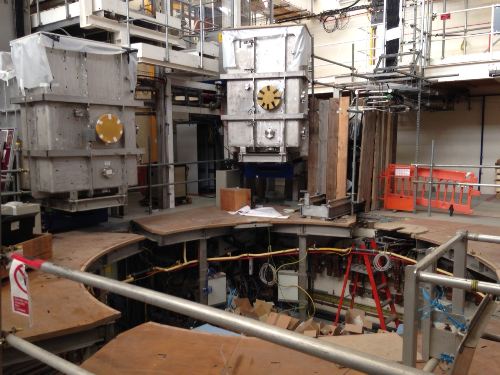
Laying the groundwork: engineers are rebuilding the Mega Amp Spherical Tokamak. (Courtesy: Michael Banks)
By Michael Banks
Yesterday I took the train from Bristol and headed to the Culham Centre for Fusion Energy (CCFE) in Oxfordshire.
Owned and operated by the United Kingdom Atomic Energy Authority, the CCFE is already home to the Joint European Torus (JET) tokamak, which in 2011 underwent a £60m upgrade programme that involved replacing the carbon tiles in the inner reactor wall with beryllium and tungsten. The purpose of this retrofit was to test the materials that are to be used in the ITER fusion experiment, which is currently being built in Cadarache, France.
Culham is also home to the Mega Amp Spherical Tokamak (MAST). MAST has a spherical plasma, shaped much like a cored-out apple, whereas JET (and ITER) has a doughnut-shaped plasma. A spherical tokamak allows for a much more compact – and cheaper – device and it is hoped that this kind of tokamak could one day be used as a potential fusion reactor.
MAST is currently half-way through a £45m upgrade of its own that will be complete sometime next year. The upgrade is a major overhaul of the facility that will see the tokamak given a new “divertor”, which extracts the waste fuel from fusion. Called “Super-X”, it is hoped that the new divertor could even be used in a future demonstration fusion plant – dubbed DEMO.
Yesterday I was given a tour of the MAST construction site, which involved donning the customary hard hat and overalls. The level of the overhaul is impressive, and it becomes immediately clear that this is not just a minor upgrade, but almost like building a new machine.
Before the MAST tour I spoke to Steve Cowley, director of the CCFE, who says that an actual fusion reactor delivering energy to the grid could even be in some way a combination of a standard fusion tokamak like ITER and a spherical tokamak. This, according to Cowley, makes the experiments that will be run with the MAST upgrade important. “This is a world-class experiment,” notes Cowley, “and one of the biggest physical-sciences facilities in the UK.”
Be sure to keep an eye out for a piece about the MAST upgrade in an upcoming issue of Physics World.
The machines such as JET, MAST and the ITER are/will be just the groping instruments in the domain of nuclear fusion that has been, for different reasons, an unreachable destination in last 60 years. Let us hope that the future would be more clement.
A bit more than hope is needed
I think it would be appropriate that what’s conceivably the ultimate technological advance (practical fusion energy) should only come hand in hand with the ultimate intellectual advance; a theory, or means to an understanding, of everything. (And that should also come with a great social advance – the discounting of prejudices to the extent that it may be plausible these advances could originate not from an army of scientists in a huge research facility but from an independent thinking person equipped with a comfy chair).
There are at least two mysterious observations re the sun that we don’t understand and could mean we don’t fully know what is happening in stellar fusion. 1 The ‘feint young sun paradox’ ie the fossil evidence that suggests the sun was consistently bright long ago when according to standard heat fusion theory it should have been dimmer. 2 The near perfect sphericity of the sun (that should be more oblate as a rotating body).
And then generally, there are the mysteries of dark matter, dark energy, how matter was generated, why the asymmetry of matter to antimatter, what is the shared origin of the standard model of particles and relativity, why the constants and why the basic laws of physics indeed?
No one should expect to have a clue as to how to achieve the ultimate goal of technology (say a safe portable fusion energy provider affordable to all) without yet having a guide that gives an answer to these questions.